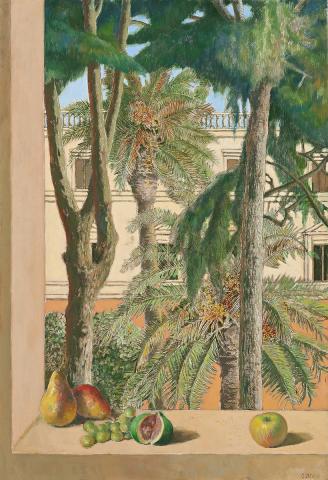STILL LIFE ON A WINDOW LEDGE, 1993
JUSTIN O'BRIEN
oil on paper on board
48.0 x 33.0 cm
signed lower right: O’BRIEN
Australian Galleries, Sydney
The Estate of the late James O. Fairfax AC, New South Wales and Bridgestar Pty Ltd, Sydney, acquired from the above in 1993
Paintings by Justin O’Brien, Australian Galleries, Sydney, 26 – 31 July 1993, cat. 18 (label attached verso)
Justin O’Brien: The Sacred Music of Colour, Art Gallery of New South Wales, Sydney, 18 December 2010 – 27 February 2011, cat. 94
France, C., Justin O’Brien: Image and Icon, Craftsman House, Sydney, revised edition, 1997, pl. 37, pp. 36, 114, 115 (illus.), 168
Pearce, B. and Wilson, N., Justin O’Brien: The Sacred Music of Colour, exhibition catalogue, Art Gallery of New South Wales, Sydney, 2010, pl. 64, pp. 144, 153 (illus.), 160
Still Life on a Window Ledge, 1993 is a superb example of Justin O’Brien’s late series of ‘window paintings’. By 1993, O’Brien was residing permanently in the Papal city, undertaking daily trips to the Vatican and visiting the Vatican Museums in which one of his paintings now hangs. The epitome of O’Brien’s naturalism, this still life is an exercise in mimesis and challenges the very purpose of pictorial representation. Remaining steadfast to his resolve to paint physical, terrestrial beauty, O’Brien worked tirelessly into his eighth decade, through the last years of his life in Italy.
Still Life on a Window Ledge is a carefully considered study, delicately detailed and vibrantly coloured. The vision is of the window of his apartment close to Via Alberico II, within the old city center of the Italian capital, a stone’s throw from the roman Castel Sant’Angelo on the banks of the river Tiber.1 Whilst it is similar in composition to other ‘window paintings’ by the artist – in particular The Window No. 2, 1978, formerly of the David Clark AO Collection – the world beyond the window frame is undeniably Roman, populated by towering cedar trees and date palms heavy with fruit. The rich terracotta and cream colouring of the façade of the neighbouring building, along with its colonnade crown, also point to its carefully recorded geographical setting. The same verdant view appears in several of O’Brien’s paintings of the period, including Woman against a Window, 1993, Summer Afternoon, 1993, and Young Girl in a Mantilla, 1995. In his last interview with Christine France, published in the revised edition of her monograph, O’Brien expressed his enjoyment of the ‘much better view… which has beautiful trees in the courtyard and from the back I look onto the Nigerian Embassy’.2
The arrangement of an offering of fruit on the windowsill, the still life subject of this painting, is simple and evocative and brings the work of Cézanne to mind. The velvety surfaces of the fruit are immediately apparent against the coarse texture of the window frame and sill. Presenting a convincing facsimile of a physical window frame, O’Brien’s execution of this vision is a near flawless trompe l’oeil. Still Life on a Window Ledge seems to radiate the warmth and fragrance of an Italian summer – one can almost hear the chirping of cicadas. In this calm abundance, O’Brien has captured the serenity of a spiritual life and invites its quiet contemplation.
O’Brien was an artist who was always in close stylistic discussion with the great artists of Western art history. The strong emphasis on tight linear composition, a smooth and flat finish and vibrant pure colours are all aspects that he gleaned not from his antipodean peers but from key figures of the Italian Renaissance. The polished restraint that pervades his pictures can be likened to the passionless exactitude of these Italian masters, in particular Piero della Francesca, who used colour and light to translate divine providence in his compositions. For a collector who had turned his attention to the Old Masters, Still Life on a Window Ledge was a contemporary acquisition in perfect harmony with the final iteration of the Fairfax collection.
Purchased from O’Brien’s second last solo commercial exhibition, Still Life on a Window Ledge is the last painting by the artist that James Fairfax bought. Throughout their respective lives, Fairfax remained fast friends with the artist, meeting him regularly during his trips to Rome and Greece. Carefully set aside in an album at Retford Park is a photograph taken at the opening of O’Brien’s show at Australian Galleries, the artist and the collector in deep conversation on either side of this painting, freshly resplendent on the wall of the gallery.
1. Grishin, S., ‘An Australian Painter in Rome: Justin O’Brien’, Art and Australia, Sam Ure Smith at the Fine Arts Press, Sydney, vol. 21, no. 4, Winter 1984, p. 493
2. France, C., Justin O’Brien: Image and Icon, Craftsman House, Sydney, revised edition, 1997, p. 36
LUCIE REEVES-SMITH
Sydney Gallery Manager
Deutscher and Hackett
